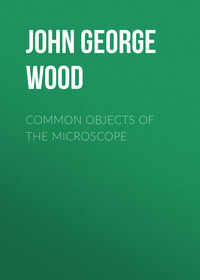
Nature's Teachings
Even bees and wasps of different kinds assist in this work, the hardest soil yielding to their small, though powerful, jaws and feet, and so being made, if only temporarily, able to carry off the superabundant moisture.
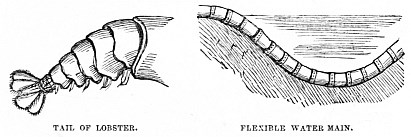
One of the most ingenious modes of Drainage was that which was invented by Watts, and was avowedly based on Nature. He had engaged himself to carry a drain tube through, or rather over, an extremely irregular bed of a river, where the pipes must accommodate themselves to existing conditions. The modern system of pipes not having been brought into existence, Watts had to adapt himself to circumstances, and did so by making his pipe on the model of a Lobster’s tail, as shown in the illustration.
We have already seen how the same object has been utilised in warfare as a pattern for armour, but it does seem rather strange that it should be employed in the tranquil arts of peace.
Another method of removing superfluous water is by the Turbine Pump, by which the water, instead of being cast up in successive jets, was flung out in a continuous torrent. Some of my readers may remember the sensation which was created at the first Exhibition of 1852 by the then extraordinary powers of the Turbine Pump.
Yet this is, after all, nothing but an imperfect copy of the now celebrated being to which human beings have been supposed to owe their origin, namely, the Ascidian, popularly known by the name of the Sea-squirt, and with very good reasons.
As a rule, it keeps up a rotation of tentacles, such as is shown in the illustration, acting exactly on the principle of the Turbine Pump, and drawing in and discharging water with a power that is perfectly astonishing in so small a being. Beside this, it has the power of flinging out at once the whole of its watery contents, and any one who has incautiously handled a mass of Ascidians, and been drenched by them, can answer with more truth than satisfaction as to the water-absorbing power of the Turbine.
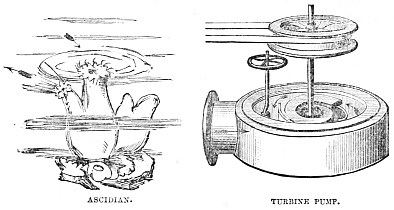
Then the Ascidian can do what the Turbine cannot do. In the Turbine the water which is taken in must necessarily be ejected in equal proportions. With the Ascidian the same thing takes place, but with the additional power of ejecting all the contained water, and then beginning afresh.
There is now no doubt that the Circular or the Turbine Pump is the most powerful in such cases as emptying mines of the water which, in spite of all precautions, will make its way in, and destroy the labours of the miners. But I merely wish to carry out the object of this work by remarking that the invaluable Turbine Pump is only a very inferior copy of a natural pump, which existed, as far as we know, centuries before Man could find his place upon this earth.
The SpiralIn an early portion of this work the Spiral or Screw was touched upon, mostly in connection with the propulsion of vessels. We will now extend it a little further, and see how it is modified so as to perform other offices than those which have been described.
Allusion has already been made to the Spiral or Wedge principle, but some of the illustrations were accidentally omitted. I therefore introduce them here, this being a chapter of miscellanea.
The Windmill has previously been described, as has also the ship’s Screw, another form of which is here given.

In the centre is shown the mechanism popularly known as the Smoke-jack, though it really works by means of hot air, and only becomes gradually choked by the soot which the smoke by degrees deposits upon it. It is, in fact, nothing but a windmill working horizontally instead of vertically, the vanes being moved by the rapidly ascending heated air. So powerful is the spiral pressure of this air, that in my old college days at least a dozen rows of heavily laden spits were perpetually turned by a single Smoke-jack. It is many years since I visited my old college, and I cannot say whether the Smoke-jack still exists, but, as it did its work well so long ago, I presume that it does so now.
Then there is the well-known spiral ventilator set in the windows of workshops. Perhaps its revolution may not assist the air-current, but it does, at all events, show how much exhausted air has to be expelled from the room, and consequently how much fresh air needs to be brought into it.
Perhaps the reader may be surprised to see that the Wings and Tail of a bird and a boy’s Kite are placed among the examples of the Spiral principle. Yet such is the fact. If the reader will move up and down the wings of any bird which will not bite him, he will find that there is in them a peculiar screwing motion, difficult of description, but very observable.
It is mostly for want of this movement that all our attempts at fitting wings to human beings have been such utter failures. We can make the wings work up and down well enough, but we cannot as yet impart to them the all-important spiral movement.
That very well-known toy, the Kite, is another example of the same principle which drives the screw steamer. Its “tail,” which need be nothing but a piece of string with a proportionate weight at the end, keeps the Kite in a slanting position, providing that the “belly-band” be properly arranged. The consequence is that the pressure of the wind acts on it as on a wedge, and so drives it upwards until the combined weight of itself and the string counterbalance the upward pressure.
Indeed, the only object of the string is to keep the Kite at a proper inclination; and, if that object could be attained by the force of gravity alone, the Kite would ascend to a height nearly double that to which it can at present attain.
Centrifugal ForceClosely connected with the spiral principle is Centrifugal Force, that marvellous power which gives to our whole solar system its ceaseless movements, and may extend, as far as we know, to other and vaster systems yet unknown.
Tie a ball to a string, and swing it round, and it will be an exact, though rough, representation of the double power by which the movements of the heavenly bodies are governed, our earth being included among them.
The string represents the force of attraction, which binds all our planets to the sun, and their satellites to the planets, while the force that is employed in swinging the ball represents the mysterious power that issues from the sun, and gives motion to the planets. The metaphor is a very homely one, but it is nevertheless correct.
In the accompanying illustration are several examples of Centrifugal Force as found both in Nature and Art. On the left hand we have diagrams of some of the heavenly bodies, showing the revolution of their offspring, so to call them, while on the right are seen examples of Centrifugal Force as applied to human use. For convenience’ sake, the illustrations have been separated into two portions.
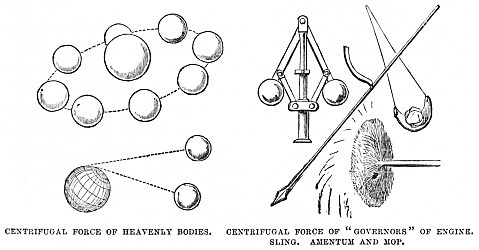
In the first of these illustrations we have the “Governor” of the steam-engine, that wonderfully ingenious and simple piece of mechanism which controls the force of the steam, and, without the superintendence of man, acts almost as a living being might.
It is composed of two heavy metal balls, hinged, as shown in the illustration, to a movable collar which slides up and down the central rod. When the engine is at work the Governor revolves, and the harder it works, the more rapid is the revolution. Consequently, as it revolves, the balls diverge and draw the sliding collar up the rod.
Here lies the whole beauty of the invention. The sliding collar is connected with the safety-valve. Thus, if the engine should be working beyond its proper powers, the Governor draws up the collar, and releases sufficient steam to take the undue pressure off the boiler. Thus the engine may be left, so to speak, to manage itself.
Next are shown two examples of Centrifugal Force as applied in ancient warfare, namely, the Sling, which is now retained merely as a boy’s toy, and the Amentum, which was practically a sling attached to a spear. Both weapons have been superseded by the modern firearms, but the Sling is really a more formidable offensive weapon, in skilful hands, than is generally suspected.
A good slinger is as sure of his aim as a good rifleman, and can send his missile to a wonderful distance. Were I to be armed with the best pistol hitherto invented, I should be sorry to fight an accomplished slinger, unless under cover.
The really tremendous power of the Sling is obtained by Centrifugal Force, the weapon, with its missile, being whirled in the air, and then one string being loosed with a peculiar knack something like the “loose” of a good archer. In consequence, the centrifugal force is converted into direct force, and the missile flies directly forwards.
The Amentum is simply a cord tied to a javelin, so that the thrower has the advantage of a lever, which, after all, is only the conversion of centrifugal force.
The very familiar Mop, flinging off its moisture to a considerable distance, needs no description; but I have introduced it to show the action of centrifugal force in small as well as in great things.
The next illustration shows how this very same power acts upon the greatest as well as the least of objects, and enables them to maintain positions which otherwise they must of necessity fail to do. Take, for example, our own Earth, and its peculiar position of being tilted on one side, so as to give us the alternative seasons as it flies on its annual course.
This is simply due to its own rapid revolution, which, on the same principle that keeps the arrow and the rifle-ball straight on their course, prevents it from altering its position.
The very same principle acts on the boys’ Tops, and is shown in a really remarkable manner by the professional Japanese top-spinners, who will place several tops upon each other, as shown in the illustration, and make them sway backwards and forwards in the most extraordinary manner, sometimes being all upright, and sometimes leaning almost at right angles to each other.
A favourite mode of illustrating this power of Centrifugal Force is by the Gyroscope, a figure of which is given on the right hand of the illustration. The interior wheel is made to revolve rapidly, and the effect of the revolution is to enable the instrument to maintain a horizontal position, even when suspended on one side, as shown in the engraving.

The power of this revolution is quite wonderful, even in a small Gyroscope which can be purchased for a few shillings. It almost seems to be alive, and to insist on retaining its position, in spite of all efforts to the contrary.
This principle is used in the swinging cabin of the Bessemer ship, and is also employed by quoit-players in keeping their missile steady as it flies towards the mark. Even the now fashionable Bicycle is managed on the same principle.
As is well known to all bicycle riders, it is comparatively easy to maintain the balance when the pace is rapid and the wheels revolving quickly. The difficulty is, to do so when the pace is slow, and the rider is deprived of the centrifugal force which keeps him on his balance almost in spite of himself. It is just the same with a child’s hoop, which runs straight and upright when it is driven rapidly, or when, for example, it runs downhill. But, as soon as the centrifugal force is expended, it begins to waver, loses its direction, and soon falls to the ground.
CHAPTER XVII.
OSCILLATION.—UNITED STRENGTH.—THE DOME
Connection of Oscillation with Centrifugal Force.—Equality of Time in Oscillation.—The Spider.—The Stone and String.—Pendulum of the Clock, and its Effect on the Machinery.—Acceleration and Retardation.—Compensating Pendulums.—The Metronome, and its Use in Music.—A simple Metronome.—Value of the Instrument in War.—The Escapement, and its Connection with the Pendulum.—Mode of Action.—Larva of Burying-beetle.—Earthworms and Serpents.—Union is Strength.—The Hippopotamus Rope and its Structure.—The Spider-web.—Distinction between the Threads.—Principle of the Dome.—The Arch, and its Connection with the Dome.—Esquimaux Huts.—Receiver of the Air-pump, and its Power of Resistance.—The Human Skull and the Egg.—Accidental Resemblance.—The Salad-dressing Bottle.—The Medusa, Strobila, and Hydra.
A portion of our last chapter dealt of Centrifugal Force. We will now proceed to another well-known power, which seems to be a variation, or perhaps a division, of the same power. I mean the principle of Oscillation, which has done so much for the present state of the world. I mention the connection of the two principles because it is evident that, if Oscillation were continued in one direction, it would be converted into centrifugal force. In fact, it can only be considered as centrifugal force interrupted.
The chief point in this subject is the equal time occupied by the oscillating body, no matter what may be the “arc” distance through which it sways, provided that the length of the line remains the same. The discovery of this principle by Galileo in a church at Florence is too well known to need repetition.
This principle may be observed by any one, and at almost any time. The Spider at the end of its line illustrates it, and so does a stone tied to a string, both of which objects are shown in the illustration.
In various departments of Art, Oscillation is absolutely invaluable. We will take, for instance, the best known of these examples, namely, the Pendulum, by which the movements of clocks are regulated. Without some mode of regulation, the works would run down rapidly, and the clock rendered incapable of measuring time. But, in the Pendulum, we possess a means of making a clock go at any desirable rate, and be faster and slower at pleasure; a long Pendulum working slowly, and a short one rapidly.
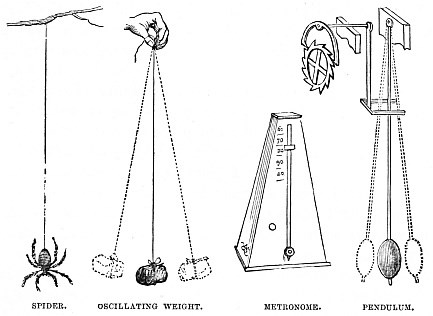
How the Pendulum affects the working of a clock may be seen by reference to the right-hand figure of the illustration. The movements of the clock are connected with the Pendulum by means of an ingenious piece of mechanism called an “escapement,” because it only allows the wheel shown in the illustration to move one cog at each swing of the Pendulum.
Now, as in the latitude of London a pendulum which is a trifle more than thirty-nine inches in length swings once in a second, it is evident that, by lengthening or shortening the Pendulum, we have the rate of the clock entirely under command.
For example, if a Pendulum be required to swing once in two seconds, it must be four times as long as that which swings once in one second, while to swing once in three seconds it must be nine times as long, the length being measured by the square of the time of vibration.
We are thus able to “regulate” clocks by lengthening the Pendulum if they be too fast, and shortening them if they be too slow. The reader will probably have remarked that the conditions of the atmosphere—such as heat, cold, moisture, or dryness—must have an effect on the length of the Pendulum, and thus alter the rating of the clock. So they do, and in consequence the Compensating Pendulums have been invented, some of them being made of metallic rods of different powers of expansion, mostly brass and steel, while others carry a quantity of mercury in a glass tube near the bottom of the Pendulum.
Another familiar example of the Pendulum is the Metronome, which is simply a Pendulum with a weight at the top as well as counterpoise below the bottom, the weight moving up or down so as to decrease or hasten the pace. Generally a bell is added to it, which is struck at the beginning of each bar.
The exactness of its beats is perfect, as is known to all musicians, and is calculated to take the conceit out of players who are apt to disregard their time. I knew one lady, a really good pianiste, before whom I placed my Metronome. Before she had played many bars she broke down, exclaiming that the horrid bell always said “ting” in the wrong place. However, she soon acknowledged the value of the instrument, and was glad to use it.
A very good Metronome may be made by fastening a bullet to the end of a piece of tape, and swinging it backwards and forwards, regulating the tape according to the time required. Such a Metronome is very portable, and extremely useful where the conveyance of the clockwork instrument would be troublesome. Moreover, its beats can be seen by a great number of persons. I have often used it myself.
Such a Metronome is used in the army, in order to regulate the pace of the soldier’s step, it being of the last importance that the pace should always be the same. Otherwise it would be impossible to calculate the time which ought to be consumed in marching a certain distance, and the military calculations on which depends the success or failure of a campaign would be wholly upset, half an hour too soon or too late meaning failure.
The EscapementAs we are on the subject of the pendulum and Escapement, we will say a few words about the latter piece of mechanism. It is here given on a larger scale than in the previous illustration, so that its action may be more easily understood. Whether in watch or clock, the Escapement is exactly the same in principle.
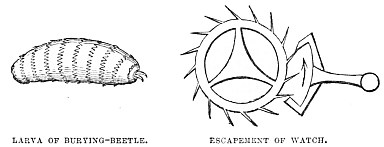
First there is the escapement wheel, the circumference of which is furnished with a number of very deep cogs, varying as to the work which they have to do. Then there comes the escapement itself, which swings on its pivot, and is regulated in its oscillations by the pendulum. As it swings backwards and forwards, it is evident that only one tooth of the wheel can “escape,” and only that in one direction.
We can reverse a steam-engine, but the man has yet to be found who can reverse a clock, i.e. enable it to continue going in the opposite direction. The only mode would be to enable one set of cogs to flatten themselves, so as to pass the escapement, and a second set to start up in exactly the opposite direction. Or perhaps there might be two parallel escapement wheels, capable of being connected or disconnected with the clock at pleasure. As, however, a reverse movement is quite needless, no such invention seems to have been made.
On the left hand is seen an example of the same principle as shown in Nature. It represents a larva or grub of the Burying-beetle. It has no legs available for locomotion, and yet it can get along with tolerable speed.
Many years ago, when living in Wiltshire, I was much struck with this fact. There had been an epidemic among sheep, which killed them off so fast that the farmers would at last not even bury them, but took off the skins, and left the bodies to moulder as they best might.
It was very unpleasant for the farmers, but just the contrary for the Burying-beetles, which simply swarmed in the deserted carcasses. If one of them were tapped with a stick, hundreds of these larvæ came scuttling out, displaying an activity which was really remarkable in creatures practically legless.
In reality this movement is achieved by an apparatus very similar in its action to that of the escapement. The rings, or “segments,” of which the body is composed, are furnished with rows of sharp points, arranged very like the cogs of the escapement wheel. By alternately elongating and contracting the body, these points catch against surrounding substances, and force the creature onwards, only allowing of movement in one direction.
Perhaps the reader will remember that in an earlier part of this work it has been mentioned that the various worms propel themselves by the same means. So do the Serpents, the edges of the scales serving the same purpose as the hairs of the worms and the hooks of the grub.
Union is StrengthON the left hand of the accompanying illustration we have an example of the wonderful power obtained by uniting together a number of comparatively weak objects. It represents a portion of the rope attached to the harpoon with which the natives of some parts of Africa attack and kill the hippopotamus.
Considering that a full-grown hippopotamus weighs several tons, and, in spite of its enormous size, is as active as a tiger, we can infer the strength of the rope which must be needed to hold such an animal when excited with rage and pain.
A few years ago the female hippopotamus at the Zoological Gardens, when deprived of her cub, actually tried to leap over the lofty iron barrier, and so far succeeded as to throw her weight on the uppermost bar. Fortunately it was made of well-wrought iron, and was only bent by her weight. Had it been made of cast-iron, like most railings, she would have snapped it like glass.
Now, the fibres of which the rope is composed are individually feeble, but, when they lend their strength to each other, their strength is amazing. It is well shown by a lasso in my possession, made of the fibres of the aloe-leaf. It is scarcely as thick as a man’s little finger, and yet it is strong enough to resist the efforts of the most powerful wild bull. I have some of the separate fibres, and it is interesting to notice how fibres so slight when separate should be so strong when united. Part of the rope has been unlaid, so as to show the manner in which it has been put together.
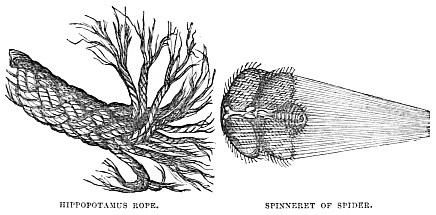
Towards the harpoon itself, a number of small cords laid loosely side by side are used, so as to prevent the hippopotamus from severing the rope with his chisel-like teeth, which he would assuredly do if it were single. The multitudinous cords become entangled among the teeth, and baffle his efforts; but still their unity is their strength; and, though the animal may sever one or two of them, the others retain their hold until he dies under a shower of spears.
On the right-hand side of the illustration is the Spinneret of the ordinary garden Spider, showing the many orifices from which the silken threads emerge. It is a remarkable point, and one which, I believe, is seldom noticed, that the Spider can at pleasure combine all these fibres into a single cord, or issue and keep them separate, just as is the case with the hippopotamus rope.
The latter operation may be seen whenever a large fly gets into the web. The Spider darts at it, bites it, and then, ejecting a loose mass of fibres, rolls it up in a moment, as in a shroud, carries it off and hangs it in a convenient place, and mends the broken meshes of the web. But both kinds of the cords of the net are made differently from the winding-up fibres, the former being fixed together, and the latter kept separate.
Principle of the DomeWe are all familiar with Domes, especially when the Dome of St. Paul’s is the most conspicuous object in our metropolis. Few persons, however, except professional architects and builders, seem to ask themselves the principle on which the Dome is constructed.
The strength of the arch is well known, and the Dome is practically a number of arches, affording material support to each other, and so enormously increasing the strength of the edifice.
A good idea of the Dome principle may be formed by taking two croquet hoops, placing them at right angles to each other, tying them together at the intersection, and pushing the ends in the ground. Even by this very simple arrangement considerable strength can be obtained; but, if the hoops be sufficiently multiplied to form a close Dome, it will be evident that the strength will be correspondingly increased.
So strong, indeed, is the Dome, that it could be made without mortar or cement, although, of course, its strength is increased by their use. A very good example of a Dome thus constructed is found in the “igloo,” or snow-hut of the Esquimaux, which has already been described.
As to the example which I have selected, it would have been easy enough to have chosen one of the great Domes of the world, such as St. Peter’s at Rome, St. Maria del Fiore at Florence, St. Paul’s of London, or St. Geneviève or the Invalides of Paris.





